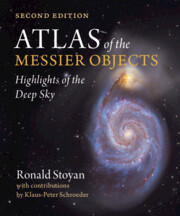Book contents
- Frontmatter
- Dedication
- Table of contents
- Also by the author
- Preface
- User guide
- Charles Messier
- The observations
- The catalog
- Statistics of the Messier objects
- Observation of the Messier objects
- Beyond Messier: The Herschel 100
- The 110 Messier objects
- Glossary of technical terms
- Contributing astrophotographers
- Index of figures
- Index of sources
Statistics of the Messier objects
Published online by Cambridge University Press: 11 April 2024
- Frontmatter
- Dedication
- Table of contents
- Also by the author
- Preface
- User guide
- Charles Messier
- The observations
- The catalog
- Statistics of the Messier objects
- Observation of the Messier objects
- Beyond Messier: The Herschel 100
- The 110 Messier objects
- Glossary of technical terms
- Contributing astrophotographers
- Index of figures
- Index of sources
Summary
Messier’s catalog of 110 star clusters, nebulae, and galaxies is the most popular list of deep sky gems. The first edition of this stunning reference atlas was hailed as the most comprehensive, detailed, and beautiful account of the Messier objects then available and the second edition continues this trend. Each object is presented with:
Updated historical information, including from new sources, featuring accounts and anecdotes from Messier and other prominent visual observers who followed him.
Thoroughly researched astrophysical information, the results of an investigation of more than 500 recent scientific papers including, for the first time, fully consistent distance data from the Gaia space observatory.
Extensive information on visual observing using the naked eye, binoculars, and amateur telescopes from modest sizes up to 20 inches aperture.
New large-scale color photos from some of the world’s best amateurs displaying the objects’ splendor, as well as close-up images from the Hubble Space Telescope, for most objects, showing the fine details.
The introductory section includes an extensive biographical portrait of the life of Charles Messier, his observations and his telescopes, and his contemporaries, and a complete translation of Messier’s original catalog. There is also detailed information on how to observe the Messier objects and advice on how to conduct a Messier Marathon. For those seeking even more, the author provides the Herschel 100 list. In addition, many objects feature historical sketches from classical observers from the nineteenth century alongside the author’s modern deep-sky drawings.
Astronomers of all abilities will delight in the Atlas’s return as your guide to the sky’s finest objects.
Information
- Type
- Chapter
- Information
- Atlas of the Messier ObjectsHighlights of the Deep Sky, pp. 53 - 62Publisher: Cambridge University PressPrint publication year: 2024
